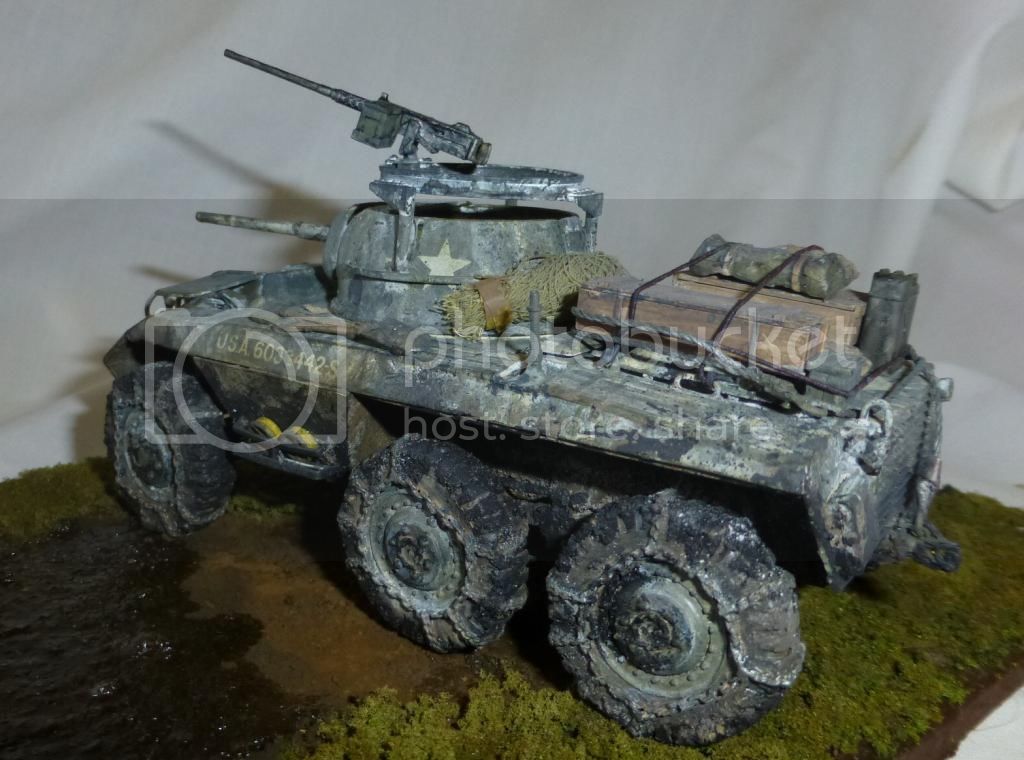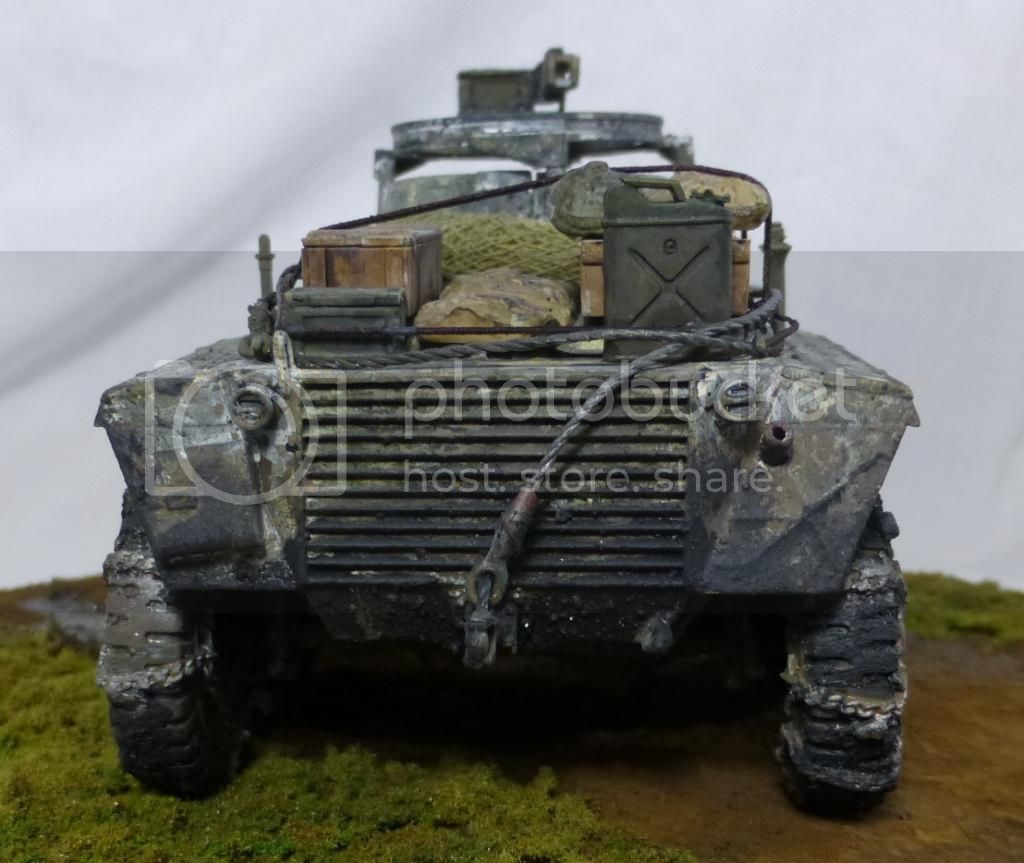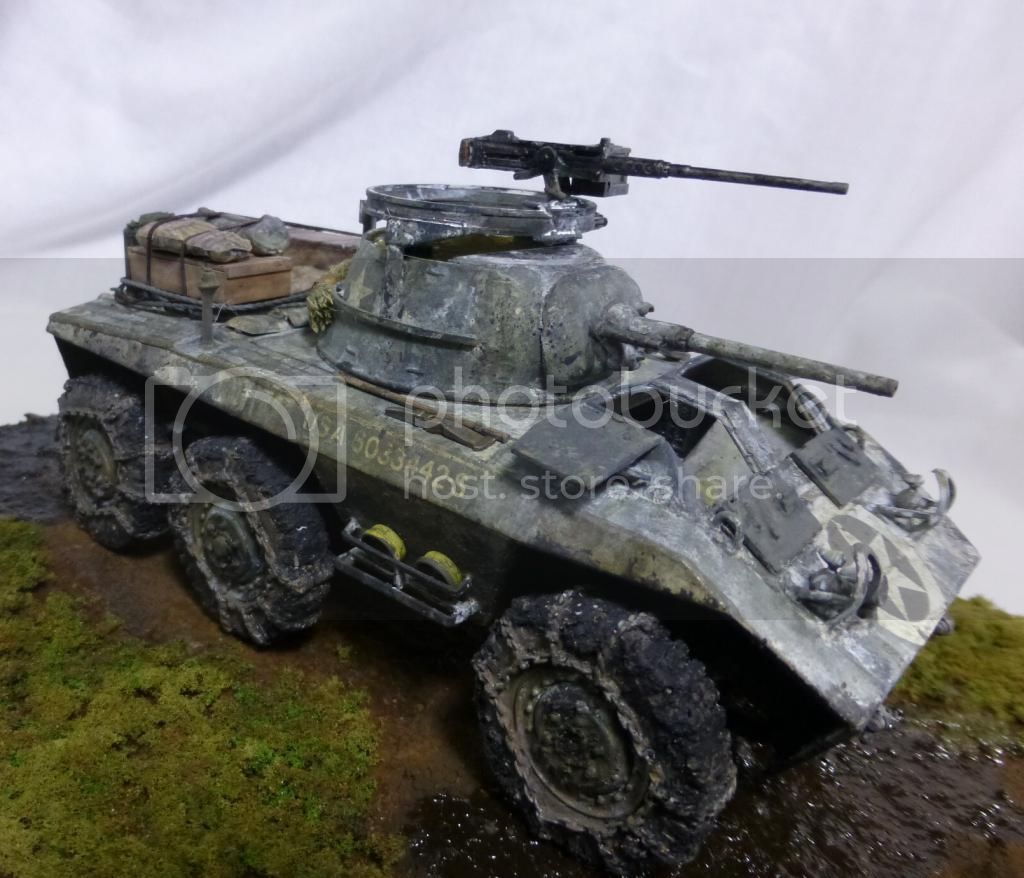Verlinden Wheels
Paints: Vallejo
Weathering: Iwata Com.Art, AK “Streaking Grimes”, Sennelier pigments; Golden mediums


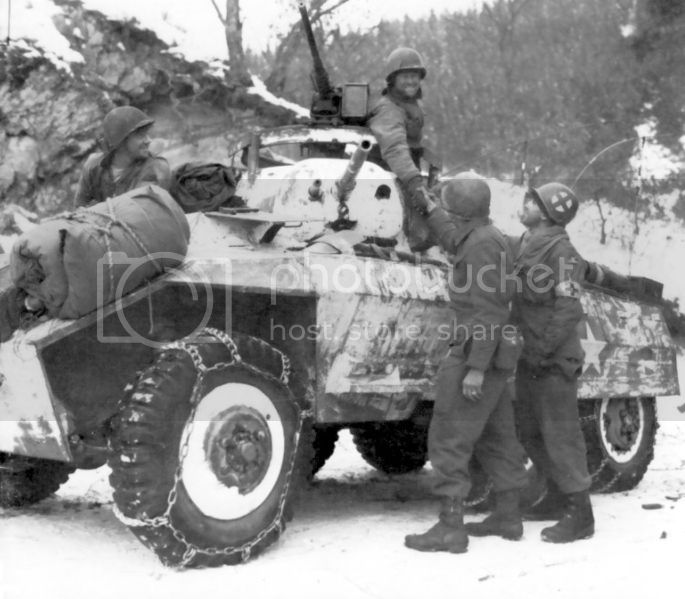

The Kit:
The M-8 is a late 90's Tamiya build so it's seriously up a notch from the classic 70s models. Part count was about 150, so you did have to stay alert. That said, the engineering and fit was excellent and made from one of the cleanest builds I've been involved with.

Although few people will ever see it, suspension and other stuff underneath is quite well detailed:
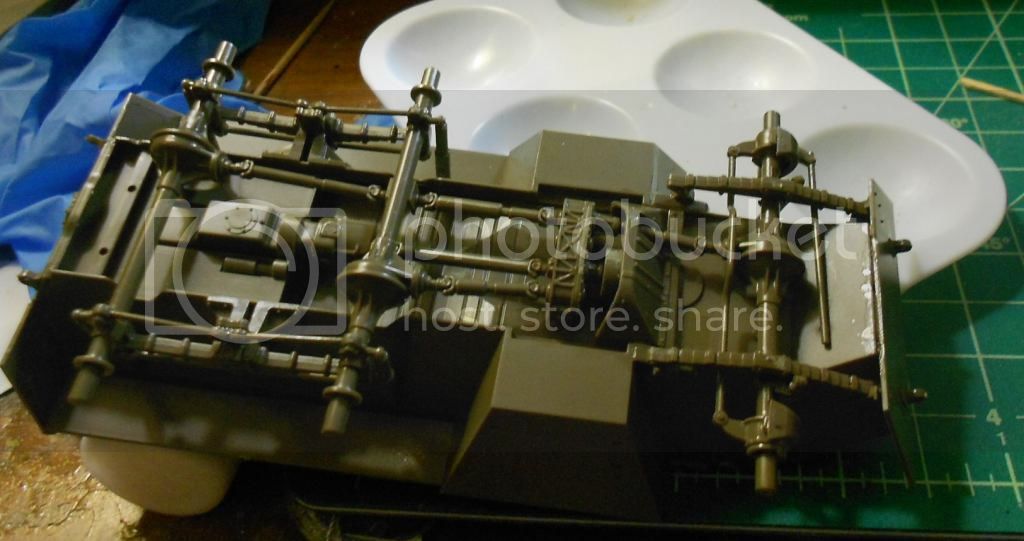
It has a full interior – no innovation because a real M-8 was pretty close to lightly armored truck with a gun, and there just isn't much there. However, I decided to open all the hatches and painted the interior off white and scruffed it while I had the best opportunity.

Beyond that all I can is that if you want a beautifully engineered kit that will allow you to deploy a sizeable options (hatches, .50 cal ring, all fenders on or off), has wonderful instructions and is priced like an airplane, I recommend the M-8. I've been culling my stash and almost all new kits I've bought for nearly a year have been Tamiya. I do not apologize. Tamiya's spanking new Jagdpanzer 70/V on deck now. (I'm not selling my DML or Tasca armor either.)
Weathering:
I began serious weathering as soon as the kit received it's base coat. Primed it with Vallejo Grey Surface Primer and I do like it. Next I employed a technique recommended by Tank Art guru Mike Rinaldi. He calls it “reverse drybrushing”. Simply put you put down a very dark base coat (in my case Vallejo MC Black Grey). At that point I give it a thin satin lacquer clear to protect the next step from getting below the dark base and down to the primer. Then comes a thin dose of AK Worn Effects which I prefer to hairspray. Then comes a coat of Vallejo Model Air Olive Drab which dries very quickly. Straight away I highlight some areas above the hull with another thin dose of Vallejo OD cut with some Yellow. As soon as it's dried for a couple of hours you take a fairly stiff brush and dampen with water and start rubbing in areas where you think there would be wear (quite a large area in a M-8 I'd guess) and the OD will begin to disappear and leave indistinct blotches of very dark grey. If the OD doesn't want to come off easily you can up the ante to Vallejo thinner or even airbrush cleaner. The OD comes off then. (Rinaldi recommends a very small amount of Tamiya/Gunze lacquer thinner – the brush barely damp. That works very well if you're working on Tamiya paints, but Vallejos are true water based paints and are a little fragile.) This technique is becoming a permanent part of the tool box. I also used a sponge and applied a small number of black/gray chips. Here's what it looks like prior to the sponge:
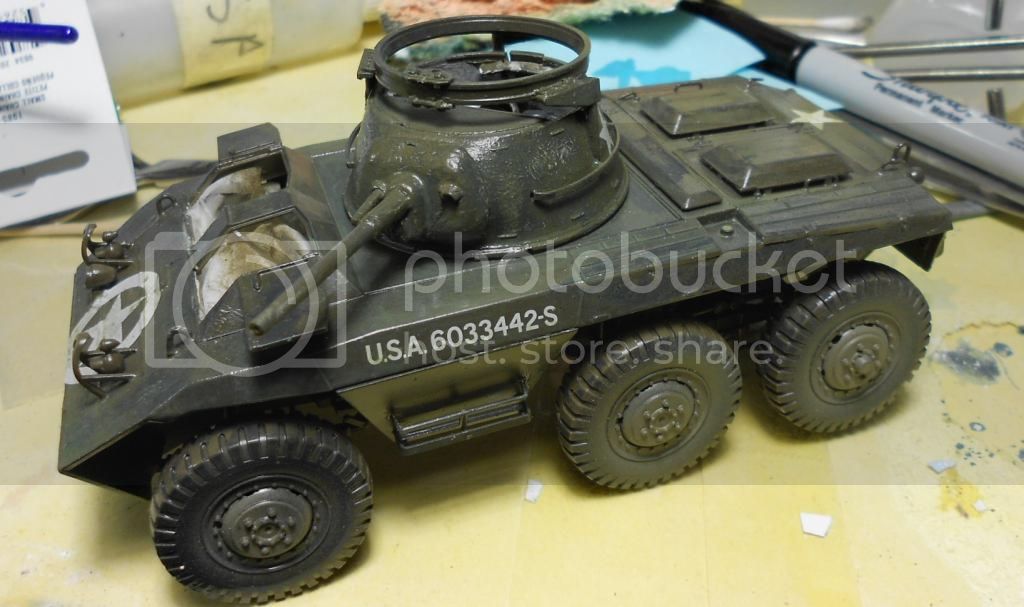
The remainder of the build was some serious weathering. The model was made for a 1945 Group Build on Finescale. That meant I wanted the fenders off. This was partially an aesthetic choice as I think the M-8 with all of its fenders on reminds one of an old Hudson or Mercury – not a complement to my eyes anyway. Here's a rebuilt M-8 with full fenders:

But history is important to me and it certainly opened the door for a heavy weather holiday. I'm thinking of maybe February 1945 somewhere close to the Rhine. There were nasty winters during WWII and lots of snow over much of the front - as pictures from the Bulge should make clear. But France has tons of water (rain, snow, streams, marshes - you name it), extremely fertile soil and I'm guessing that when the thaw began that there would have been a lot of mud. You also would probably seen the first bits of new foliage when there was still some snow present. (On May 1 in Minnesota last year there was a cold snap and late snow. A week later the snow was gone and the leaves were blooming - nature in overdrive. Anyone who lives with winters will know what I'm getting at.) US AFVs, like everyone's, were given a coat of whitewash when the snow was there. Looks like it was a field modification - I've seen films of crewmen slopping the stuff on with a big brush. That tells me that the stuff was water based - might even have been applied as often as needed. I'm also guessing that the whitewash would have worn off and unevenly. With sleet and rain that would have created a lot of streaking. My Minnesota car gets very dirty very fast during the thaw and it never leaves paved roads. The M8, although a 6X6, was too heavy to be a good off-roader. Recon units preferred the jeeps for cross country stuff. But Greyhounds would still have often left the roads and found the mud. Also, in 1945 France there would have been hundreds of miles of unpaved roads. I think in the best of conditions AFVs at the front were very untidy - one in the thaw would have been covered with dirt and mud - and you can bet the crew didn't wipe off their boots when getting in and out. I was a little uncertain about the chains on the wheels (courtesy of Verlinden). As I found out the hard way, chains on pavement at highway speed can come off very quickly. But I'd guess it was rare for a M-8 to move over 20mph. (I once talked with one of Patton's tankers at the Bulge and he said that if you were in a combat zone you moved forward in "baby steps." I bet. Also, if an army moved 40 miles in a day in WWII it was really moving. Between the slow down of the allied advance in September 44 and the dramatic breakout after the Rhine crossings in March 45 fighting was hard and movement slow. I think the first photo above gives a pretty idea of how badly beat-up most AFVs were. M-8 duty was risky and they were very vulnerable to mines. But I would guess that casualty rates would have been lower than for tanks, and I'd guess there were a goodly number of M8s that went from Normandy to Prague if there was time to rebuild the running gear a couple of times. I think they would have been tired machines and beastly muddy.
Stage one was the application of three filters made of transparent Com.Art Colors and Vallejo acrylic washes. I wanted a satin finish for the upcoming white wash. I used Com.Art opaque white for the whitewash. The stuff worked like a charm. (Should note that I put no whitewash over the insignias or ID numbers – it does appear they were left just dirty. Anyway, that's why OD is easiest to see there.) It doesn't adhere well to styrene so it was simple to rub it off after drying. Some I took off in chunks to make it look as though some whitewash come off in clumps all at once. More was worn off with water making it appear that the whitewash was wearing off during the thaw and the sleet/rains that would have accompanied it. Sometimes I felt I had taken off too much so I reapplied bits almost like chipping creating white blotches. I regret that I didn't take more photos during the build – dumb not have a pic of the kit after the whitewash was laid on. I then applied a coat of matte clear. I find a matte surface is good for pinwashes and I applied a good number of them with Vallejo washes and Com.Art. I also put on a goodly dose of two colors of AK “streaking grime” creating streaks in large number. I think that's something that would happen as an already dirty and whitewashed vehicle, covered with muddy boot prints got hit by the sleet and heavy rains that you'd find in this theater. (There's a reason the land near the Rhine is excellent – it gets buckets of rain to keep the rivers and streams up. General Mud operated in every theater of the ETO – ever check pics of US vehicles in Tunisia in December 1942?)
I stared at a lot of M-8 photos and it appears that the well muddied vehicles had chains on the tires. I didn't have the right gauge of anchor chain to use on wheels. It would have been a proper challenge, but for the same price ($10) I could buy a six pack of resin tires with chains from Verlinden. I've worked very little with resin, so why not? They proved to require some serious drilling to allow them to mount properly (even I wear googles and mask for that stuff) they did look neat. Here are three painted by moi but pre-pigment:

For pigments I employed Sennelier: this stuff is for looney painters that want to make their own paints, and it is extremely fine and beautifully colored. Like a lot of art materials it's much cheaper per volume than something sold by modeling companies like MIG or AK. I built up several layers of pigments using ISP or mineral spirits for adhesive. I made mud with pigments cut with matte acrylic paint and given texture by matte medium from Liquetex. I much prefer this method to plaster because the medium will dry clear (you wouldn't need paint, but I had matte brown which was a great color) and hence you don't have to worry plaster changing the color. I also put in some extremely fine sand. I did use a new product that impressed me. MIG has just begun offering a product called MUD. It comes in different colors, opacity and texture. I used European Wet Mud Fine Texture. When I first put it on I thought it was black. Looking more closely I decided it was a very dark brown. I made another batch of Sienna paint with Golden Gloss Medium and put both colors (mostly MIG) on the wheels, irregularly under the hull and splotches applied on the lower upper hull with the mud on a paintbrush and shooting air through it with an airbrush.
I had some military accessories from Academy and I put a bunch on. There's also a roll of Verlinden netting from and earlier project. (Next time I'll see if I can scratch some stuff that's better. Frankly the real world was breathing down my neck frequently and I was suffering from project fatigue. So I used what I had.) I put together a quick base using several colors of grass, and a road of brown pigments running down the middle. There are puddles of both wet muds – they get their extreme “puddle” effect because I put down Woodland Scenic “Realistic Water” on both of them. Very good stuff.
Should note that this model was extremely difficult to photograph. When you get a multitude of earth colors next to each other it's easy for them to bleed into each other. And then the eye has to interpret them. So some photos had too much green: some too much white: some were just badly done. I think the ones here a fair representation. Or maybe not. I took all of them in macro mode. I've got the kit sitting – temporarily- at a good place where I put my most recent models. From my chair about five feet away the whitewash is considerably more prominent than in the close-ups.
I'd like opinions if possible. Often I get so-so results because of so-so talent. But what you see here is pretty much what I wanted. So the error is not in my hand on this kit, but in my eye. I like it, but wiser heads may disagree and I'd like to know why.
Pics below
Eric
